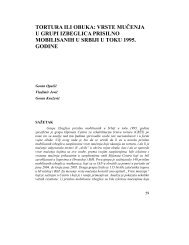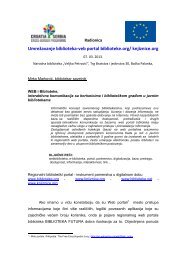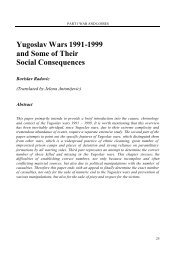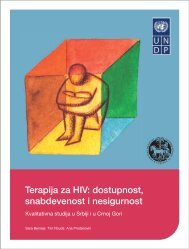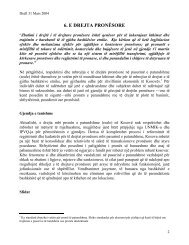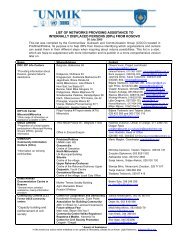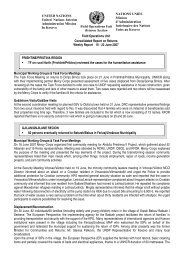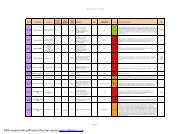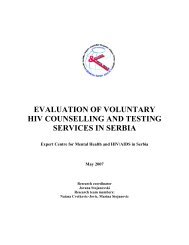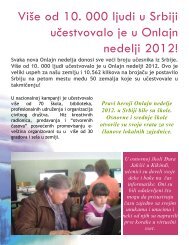Download book (PDF file 742 kB) - IAN-a
Download book (PDF file 742 kB) - IAN-a
Download book (PDF file 742 kB) - IAN-a
Create successful ePaper yourself
Turn your PDF publications into a flip-book with our unique Google optimized e-Paper software.
INTERNALLY DISPLACED PERSONS<br />
from the PRIZREN AREA of KOSOVO<br />
and METOHIJA: awaiting return for<br />
three years<br />
www.ian.org.yu<br />
<strong>IAN</strong> Research Team<br />
Belgrade, 2003<br />
i
I INTRODUCTION<br />
II RESEARCH GOALS<br />
CONTENTS<br />
1<br />
5<br />
III RESEARCH METHODS<br />
6<br />
Instruments 6<br />
Sample 7<br />
Procedure 8<br />
IV RESULTS 9<br />
Structure of the Prizren area IDPs 2002-sample<br />
according to the age, education, profession, marital<br />
status and family size<br />
9<br />
A. Living conditions and financial status of IDPs from<br />
the Prizren area: two years later<br />
B. Mental health status of the Prizren area IDPs: two<br />
years later<br />
C. Position of the Prizren area IDPs on return to their<br />
home area: two years later<br />
V CONCLUSIONS AND RECOMMENDATIONS<br />
14<br />
17<br />
26<br />
31<br />
References 34<br />
i
I INTRODUCTION<br />
After the formal ending of the 1998-1999 Kosovo conflict and<br />
cessation of NATO bombardment of FR Yugoslavia in 1999, a great<br />
number of Serbs and other non-Albanians from the Prizren area fled<br />
their homeland and were displaced and expelled to other parts of<br />
Serbia and to Montenegro. According to the earlier reports of the<br />
respective estimates of certain international organisations (UNHCR,<br />
ICRC), about 200 000 persons were forcibly displaced into the parts<br />
of Serbia outside Kosovo and Metohija. In the UN OCHA Office report<br />
from April 2002 it was stated that 231 000 IDPs from Kosovo and<br />
Metohija live in Serbia and Montenegro (WWW document, URL: www.<br />
reliefweb.int/<br />
library/documents/2002/ocha-yug-26apr.pdf).<br />
According to the current official estimations of the Coordination<br />
Centre of FRY and of the Republic of Serbia regarding Kosovo and<br />
Metohija (WWW document 2002, URL:<br />
http://www.serbia.sr.gov.yu/coordination_centre/), from the total<br />
number of about 280 000 internally displaced persons and expellees<br />
from the Kosovo and Metohija region, some 30 000 (or around 11%)<br />
originates from the Prizren area.<br />
Although their formal status is different from the status of the<br />
refugee population (for details see Playe, 2000), IDPs from Kosovo<br />
and Metohija have practically a lot of things in common with the<br />
refugee population. Main characteristics of the population of internally<br />
displaced persons from Kosovo are:<br />
• Direct exposure to one of the so-called catastrophic stressors<br />
(Lazarus & Folkman, 1984) – forcible mass exile from<br />
homeland and in relation with that the loss of financial<br />
stability, labour status, network of formal and informal social<br />
relationships or, in other words, the state of being<br />
regionally, socially and psychologically uprooted. (Vlajković,<br />
2000a; Milosavljević, 2000);<br />
• exposure to a great number of stressors before the actual<br />
forcible displacement (Vlajković, 2000b);<br />
• feeling of lost identity, because the "questions of `who we<br />
are ’ are often intimately related to the questions of `where<br />
we are ’” and "`home’ places are organised and represented<br />
in ways that help individuals to maintain self-coherence and<br />
self-esteem, to realise self-regulation principles"(Dixon &<br />
Durrheim, 2000, p.29);<br />
• strong feeling of insecurity, i.e. "dependence on the will and<br />
interest of others" (Milosavljević, 2000, p.23);<br />
• traumatisation by living in a new environment during the<br />
hard process of adaptation to the new environmental<br />
conditions, interwoven first with sorrow because of the<br />
1
losses, and later with the necessity to bring crucial decisions<br />
regarding the future life (Vlajković, 2000b).<br />
Besides all this, in the last two years IDPs from Kosovo and<br />
Metohija were faced with the transition changes of the current system<br />
in their own country, disappearance of old institutions and creation of<br />
new ones, i.e. the so-called birth of “democracy” on the ruins of war,<br />
previous regime and international isolation.<br />
For almost four years of their life in exile the Internally<br />
Displaced Persons from the Prizren area of Kosovo (hereinafter<br />
identified as PrIDPs) have dwelled in a vicious circle between the<br />
wish to return to the homeland and awareness that the return is not<br />
objectively possible at the present time. The non-existence of clear<br />
legislative and, which is far more important, guaranties for personal<br />
safety of the returnees to Kosovo and Metohija really applicable on<br />
the field, the climate of insecurity that is still a part of everyday life in<br />
places they were exiled from, actual impossibility to freely access<br />
property, openly manifested reluctance of the extremists within the<br />
Albanian majority to accept tolerance and reconciliation with the<br />
returnees, are obstacles for the return of the non-Albanian population<br />
to their homeland that they were forced to leave almost four years<br />
ago. The right to return, which is not only a wish of the great<br />
majority of them but also one of their basic human rights, is at<br />
present only a fictional right. The situation in Kosovo and Metohija<br />
has not been changing in a direction favourable for them: this area is<br />
under the international administration of UNMIK, with very limited<br />
freedom of movement for the non-Albanian population that lives in<br />
strictly protected enclaves. This is how the U.S. Committee for<br />
Refugees describes the current situation in Kosovo:<br />
"Despite failing to show significant popular support among ethnic<br />
Albanians in Kosovo during October 2000 municipal elections...ethnic<br />
Albanian militants mounted well-organized acts of violence and<br />
intimidation against minorities. Violence and threats were directed<br />
particularly at would-be minority returnees to Kosovo... The threat of<br />
violence continued to prevent the return of most displaced Serbs and<br />
other minorities, including Roma, Ashkalis, and “Egyptians” (RAE) to<br />
their homes in Kosovo... With an estimated unemployment rate of<br />
more than 60 percent, and continuing crime, political instability, and<br />
ethnic polarization, Kosovo was slow to recover from the full-scale<br />
armed conflict of 1999. Both ethnic Albanian and ethnic Serb<br />
militants strove to consolidate the ethnic divisions that they had<br />
created after the deployment of NATO troops, called KFOR (for<br />
Kosovo Force)...."(cited from the URL: http://www.refugees.org<br />
/world /countryrpt/europe /yugoslavia.htm)<br />
In 2000 <strong>IAN</strong> Research Team conducted a research on the<br />
sample of 1630 PrIDPs, with the main purpose to provide useful<br />
information on socio-demographic, educational and professional<br />
characteristics of the Prizren area IDPs, on their living conditions, aid<br />
2
needs, mental health status, and their position on return to the<br />
homeland (Tenjović, Knežević, Opačić et al. 2001). Data obtained<br />
through this research showed favourable educational and professional<br />
structure of the PrIDP population, as well as a high business<br />
competence and marked readiness for credited entrepreneurship in<br />
this group of expellees. On the other hand, the data clearly showed<br />
rather unfavourable living conditions of the PrIDPs in exile (high rate<br />
of unemployment, feeling of complete dependence on humanitarian<br />
aid with, at the same time, very prominent dissatisfaction with the<br />
received humanitarian aid). It also revealed a disastrous status of<br />
their mental health (prevailing sense of deteriorating current mental<br />
health condition compared with their mental health condition prior to<br />
exile, extremely high level of intrusive component of posttraumatic<br />
response syndrome and very pronounced symptoms of anxiety,<br />
paranoid ideation and somatisations).<br />
Since October 2000, after the fall of the Slobodan Milošević<br />
regime, together with the creation of democratic institutions after a<br />
decade of isolation, FR Yugoslavia has been struggling for the<br />
quickest possible recovery into the international community. A new<br />
system that is gradually being established in Serbia is, in a way, a<br />
great chance for opening new possibilities for repatriation, i.e. return<br />
to homeland with the assistance of the international community, or<br />
integration of internally displaced persons into the new environment.<br />
Every type of assistance, both in possible reaching a decision to<br />
return to the homeland and in reaching a decision to permanently<br />
remain in the new environment and integrate into it, includes good<br />
knowledge of the current status and personal views of the group that<br />
the assistance is intended for. Two years have past after the previous<br />
research conducted by the <strong>IAN</strong> research Team (supported by Danish<br />
Secretariat for Peace and Stability /FRESTA/ and European<br />
Commission) whose goal was to find out more about living conditions<br />
and mental health status of IDPs from the Prizren area. This time<br />
period is long enough for the changes to occur in specific populations<br />
such as the population of PrIDPs. Hence, the main purpose of the<br />
investigation, whose results are reported in this text, was a) to<br />
explore current living conditions of the Prizren area IDPs (PrIDPs),<br />
their current mental health status and their personal views regarding<br />
return to home area and b) to compare current data with the data<br />
gathered two years ago within the same population. It was not<br />
possible, however, to gather data by examining exactly the same<br />
persons as two years ago. Instead, we have decided to use a new<br />
sample that would be as similar as possible regarding the important<br />
characteristics to the sample from the year 2000 (and that could be<br />
rightly assumed to represent the population of those PrIDPs who are<br />
literate and older than 14). In this way we wanted to reach timely<br />
and accurate information on possible changes in the living conditions,<br />
mental health status and position regarding the return to home area<br />
3
that might have occurred during the past period among the PrIDP<br />
population.<br />
4
II RESEARCH GOALS<br />
Research goals, in compliance with its main purpose, were the<br />
following:<br />
A. To explore current living conditions and financial status of<br />
the PrIDPs and to compare current data with the data<br />
obtained from the sample of the same population two years<br />
ago;<br />
B. To screen the Prizren area displacees’ current mental health<br />
status and to compare current data with the results obtained<br />
from the sample of the same population two years ago;<br />
C. To examine the Prizren area displacees’ position on return to<br />
home area and to compare current data on that issue with<br />
the data gathered from the sample of the same population<br />
two years ago.<br />
5
III RESEARCH METHODS<br />
Instruments<br />
The data were gathered employing the same questionnaires and<br />
inventories as two years ago (Tenjović, Knežević, Opačić et al. 2001)<br />
except that the general questionnaire was modified by exclusion of<br />
some questions and by inclusion of several new questions related to<br />
the PrIDPs` position on return to homeland. Therefore, the following<br />
instruments were included in the research:<br />
1. General Questionnaire designed by the <strong>IAN</strong> research team<br />
provided data on the sociodemographic characteristics of the<br />
examinees (gender, age, nationality, marital status, number of<br />
family members, number of children, type of the place of origin<br />
/town-village/), their educational level, occupation and<br />
employability (working ability), their current financial and living<br />
conditions (employment, monthly income per family member, type<br />
of accommodation in exile, need for humanitarian aid, satisfaction<br />
with the humanitarian aid received, self-estimate of current living<br />
condition), and their current mental health status (need to talk<br />
with a professional due to psychological difficulties, use of<br />
tranquillisers, self-estimate of current psychological condition).<br />
The separate section of the general questionnaire was designed to<br />
explore examinees' views related to return and to the factors that<br />
have impact on decision making process about the return to home<br />
area (interest for events in the home area, most frequently used<br />
sources of information about homeland, frequency of visits to the<br />
homeland, maintenance of contacts with persons of the same as<br />
well as other nationalities who live in the place of origin of the<br />
displacees, personal readiness to return, conditions required for<br />
return, having a plan to return in the near future, estimation of the<br />
importance of certain conditions the fulfilling of which could<br />
facilitate the process of reaching a decision on return to<br />
homeland).<br />
2. Life event check list (LECL), designed by the <strong>IAN</strong><br />
research team, is employed for assessing the extensity of<br />
exposure to extremely stressful life events. It comprises a list of<br />
17 extremely stressful life events. The examinee checks each<br />
event according to the following scale: "It happened to me", "I<br />
have witnessed it", "I have learned from somebody else’s<br />
experience", "I am not certain" or "It is irrelevant for me".<br />
6
3. Impact of event scale (IES) (Horowitz, Wilner & Alvarez,<br />
1979) a self-report instrument for assessing severity of<br />
posttraumatic distress. The examinee checks each item on a fourpoint<br />
scale (“not at all”, “rarely”, “sometimes”, “often”), indicating<br />
in that way how frequently he had the experiences described by<br />
the item during the last seven days. The responses to each item<br />
are measured by 0 (“not at all”), 1, 3 or 5 (“often”) for the<br />
frequency categories, respectively. The scores of intrusion,<br />
avoidance and total score of posttraumatic distress are obtained as<br />
a sum of measured responses.<br />
4. Symptom check list- SCL-90-R -a self-report inventory<br />
comprising 90 items for the assessment of current psychological<br />
symptom pattern, current distress and global psychopathological<br />
status (Derogatis, 1983). The examinee rates each item on a fivepoint<br />
scale (from “not at all” to “extremely) according to the<br />
degree of distress during the last seven days. The nine symptom<br />
dimensions (Somatisation, Obsessive-Compulsive, Interpersonal<br />
Sensitivity, Depression, Anxiety, Hostility, Phobic Anxiety,<br />
Paranoid Ideation and Psychoticism) and certain global indices of<br />
distress can be derived from responses to the items. In this<br />
research Global Severity Index (GSI) was employed as a measure<br />
of global distress or psychopathological status.<br />
5. NEOFFI personality inventory - is composed of 60 items<br />
(Costa & McCrae, 1992). The examinee responds by choosing one<br />
answer on a five-point scale (from "Strongly Disagree" to<br />
"Strongly Agree"). NEOFFI was used in this research for the<br />
assessment of five personality traits describing personality in<br />
accordance with the currently most widely accepted Big-Five<br />
personality model: Neuroticism, Extraversion, Openness,<br />
Agreeableness and Conscientiousness (Digman, 1990).<br />
Sample<br />
To enable comparison with the data obtained on the PrIDPs two<br />
years ago, the sampling plan included gender, education level and<br />
nationality as the stratification factors. The <strong>IAN</strong> team members<br />
randomly selected sample units during the regular field contacts with<br />
internally displaced persons from the Prizren area, paying great<br />
attention to stratification factors in the sampling plan. With regard to<br />
the purpose of this research and the fact that the data were gathered<br />
through questionnaires, only persons over 14 were included in the<br />
sample.<br />
The final sample selected in that way consisted of 391<br />
Internally Displaced Persons (IDPs) from Prizren (and the surrounding<br />
7
villages), 177 (45,3%) females and 214 (54,7%) males, aged<br />
between 15 and 77 (Median Age= 42; Mean Age= 42,33; Standard<br />
Deviation= 15,12). Almost all examinees, 377 (96,4%) of them, were<br />
of Serbian and Montenegrean nationality. There were 10 persons<br />
(2,6%) of other nationalities, while 4 persons (1,0%) did not give<br />
data on their nationality. In the sample there were 310 persons<br />
(79,3%) who lived in urban areas before the displacement, 80<br />
(20,5%) examinees fled from villages, and for 1 examinee there is no<br />
data whether he/she lived in a town or a village.<br />
The sample structures according to age categories, educational level,<br />
profession, marital status and family size are presented in the Results<br />
section of this paper.<br />
Procedure<br />
The <strong>IAN</strong> team gathered the data from October to December<br />
2002. The questionnaires were handed out to the selected IDPs older<br />
than 14 who were requested to fill them in. The examinees were<br />
asked to answer all the questions as sincerely as possible since their<br />
responses would be very useful in providing better-quality assistance<br />
to them or any other people who might in future find themselves in<br />
the similar position. All the examinees filled in the General<br />
Questionnaire by themselves or with the help of an examiner (if<br />
needed), while the questionnaires IES, LECL, IES, SCL-90-R and<br />
NEOFFI were filled up only by the examinees able to do it by<br />
themselves. At the end of the General Questionnaire, the examinees<br />
were informed in written form that, if they felt the need to talk with a<br />
professional, they were free to contact <strong>IAN</strong> counselling agencies<br />
offering free psychological assistance.<br />
8
IV RESULTS<br />
By this research it was planned to contrast the data obtained<br />
from the PrIDPs sample used in this research (hereinafter identified<br />
as "2002-sample") with the data gathered in the year 2000 on the<br />
sample from the same population (hereinafter identified as "2000-<br />
sample"). Therefore, at the beginning of this section we will give a<br />
more detailed presentation of the sociodemographic characteristics of<br />
the 2002-sample contrasting them with the comparable data from the<br />
2000-sample.<br />
Structure of the Prizren area IDP 2002-sample according to<br />
the age, education, profession, marital status and family size<br />
The 2002-sample structure according to the age categories,<br />
educational level, profession, marital status and family size are<br />
presented in Tables 1, 2, 3, 4 and 5. In these tables, in a separate<br />
column named "% in the 2000-sample" the percentages are given as<br />
the indicators of the relative representation of certain categories in<br />
the sample of 1630 PrIDPs examined in 2000. Considering the size of<br />
this sample, these percentages can be recognised as reliable<br />
estimates of the representation of certain categories in the whole<br />
population of displaced persons from the Prizren area who are literate<br />
and older than 14. The fact is, also, that the statistical testing of the<br />
homogeneity of distributions using the Chi-square test on the<br />
samples of this size practically always leads to “statistically significant<br />
differences” among distributions. Therefore, instead of the statistical<br />
significance, the Cramer's V-coefficient was used as the key indicator<br />
of the "similarity" of distributions, since this coefficient is not<br />
sensitive to the size of samples but primarily to the differences<br />
among the distributions. If the Cramer's coefficient is lower than<br />
0.10, the sample distributions can be from the practical point of view<br />
considered rather similar, i.e. “negligibly different” regardless of the<br />
statistical significance of the difference.<br />
As it was already said when describing the samples, in the<br />
2002-sample there were more males than females (54,7%:45,3%),<br />
while in the 2000-sample the number of males was almost identical<br />
with the number of females (49,9%:50,1%). However, difference in<br />
gender structure of these two samples is very small (Cramer's<br />
V=0.04; n.s.). This sample, just as the 2000-sample, is also<br />
characterised by high ethnic homogeneity: 96,4% of the examinees<br />
in both samples are of Serbian or Montenegrean nationality (Cramer's<br />
V=0.04; n.s.).<br />
The 2002-sample consisted mainly of displacees from the town<br />
of Prizren (79,3%), and a far smaller number of the examinees was<br />
from villages near Prizren (20,5%; No data: 0.2%), similarly as in the<br />
9
2000-sample (83,1%:15,1%; No data:1,8%) (Cramer's V=0.07;<br />
p
and relatively higher proportion of examinees with a university<br />
degree, than in the 2000-sample (Cramer's V=0.10; p
Table 4: Distribution of IDPs from the Prizren area according<br />
to marital status<br />
Marital status n % % in the PrIDP<br />
sample from the<br />
2000<br />
(n=1630)<br />
Single 110 28,1 23,3<br />
Married 250 63,9 65,0<br />
Divorced 8 2,1 2,0<br />
Widowed 10 2,6 8,0<br />
No data 13 3,3 1,7<br />
Total 391<br />
As can be seen from Table 5, the 2002-sample and the 2000-<br />
sample are more similar than dissimilar with respect to the number of<br />
family members (Cramer's V=0.07; p 92 23,5 20,1<br />
No data 11 2,8 5,1<br />
Total 391<br />
•••<br />
The 2002-sample of the PrIDPs is not markedly dissimilar with<br />
the 2000-sample of the PrIDPs regarding the main sociodemographic<br />
characteristics to. The most prominent differences between these two<br />
samples are concerned with the age, educational and professional<br />
structure: in the 2002-sample, comparing to the 2000-sample, there<br />
is a higher relative proportion of representation of the examinees<br />
between 25 and 34 years of age as well as those between 55 and 64,<br />
while there is a relatively lower proportion of the expellees younger<br />
than 24 and older than 65; in the 2002-sample the educational and<br />
professional structure is even more favourable than in the 2000-<br />
sample. Due to the size of the samples, even small dissimilarities<br />
reach statistical significance. Therefore, obtained values of the<br />
12
Cramer's V-coefficient, which very rarely reach over 0.10, bring us to<br />
a conclusion that these samples, at least regarding sociodemographic<br />
characteristics, can be considered very similar. They are similar<br />
enough so that, when contrasting the results obtained in two time<br />
points (with a two-year interval between) on these two samples, they<br />
may be recognised as indicators of possible “changes” or “nonchanges”<br />
regarding the main target characteristics (living conditions,<br />
mental health status and positions on return to homeland) of the<br />
PrIDP population.<br />
13
A. Living Conditions and financial status of IDPs from the<br />
Prizren area: two years later<br />
Compared to the period two years ago, living conditions and<br />
financial status of the PrIDPs are not better at all:<br />
Most of the examinees are currently privately accommodated in<br />
rented flats (58,6%) just as it was the case in the year 2000<br />
(64,8%), and a far smaller percentage is accommodated with<br />
relatives or friends (21%; 2000-sample: 21,8%). Among the<br />
examined PrIDPs 12 % live in refugee camps (2000-sample:<br />
4,1%), 7,7% of them own a house or a flat (2000-sample:<br />
8,5%), and 3 examinees (0,8%) did not give data on the type<br />
of their accommodation (2000-sample: 0,7%).<br />
When the data from only those examinees who gave<br />
information on their employment are considered (95,1% in<br />
each sample), the unemployment rate estimated on the basis<br />
of the 2000-sample was 79,1%, while in the 2002-sample<br />
there are 84,1% unemployed (Sample /2000-2002/ by<br />
Employment /yes-no/: Chi square = 4.78, df =1, p < 0.05).<br />
This data is even more important in the view of the fact that a<br />
relatively higher percentage of the PrIDPs from the 2002-<br />
sample considers himself/herself able to work (68,3%) than it<br />
was the case with the examinees from the 2000-sample<br />
(56,9%). The percentage of the unemployed within the PrIDP<br />
population is much higher than the unemployment rate in the<br />
general population of Serbia (about 20% to 30%) or in the<br />
populations of the internally displaced persons in other<br />
countries (for example in IDP population in Georgia there are<br />
about 40% unemployed, while the unemployment rate in the<br />
general population is, similarly as in Serbia, around 20%;<br />
according to Dershem & Gurgenidze, 2002).<br />
The average monthly income per family member of those<br />
stating the data in the 2000-sample (58,5% of them) was<br />
13,54 EUR (Standard deviation=11,54). In the 2002-sample<br />
the average monthly income per family member of the PrIDPs<br />
stating the data (87,7% of them) amounts to 40,58 EUR<br />
(Standard deviation=26,65). It is obvious that the average<br />
nominal monthly income has grown (Average monthly income<br />
by sample: F (1;1298) =652,50, p< 0.0001). However, the real<br />
costs of living in Serbia have increased, and therefore it can be<br />
concluded that the financial situation of the PrIDPs is not at all<br />
better than it was two years ago;<br />
Very small change for better has occurred regarding the<br />
dependence on humanitarian aid: while in the 2000-sample,<br />
only 0.6% of the examinees gave a negative answer to the<br />
question "do you consider the humanitarian aid needed", in the<br />
14
2002-sample the percentage has risen to 5,6% (Sample by<br />
Need for humanitarian aid /yes-no/: Chi square =53.78, df =1,<br />
p < 0.0001). This small change for better is probably a<br />
consequence of the smaller number of the eldest examinees in<br />
the 2002-sample, than a result of realistically decreased need<br />
for humanitarian aid among the population of the PrIDPs. This<br />
conclusion is reached according to the data on the level of<br />
satisfaction of the IDPs 2002-sample with the received<br />
humanitarian aid: dissatisfaction with the received<br />
humanitarian aid is more prominent now than it was two years<br />
ago (see Graph 1). While in the 2000-sample 74,9% of the<br />
examinees was completely or mostly dissatisfied with the<br />
received aid, in the 2002-sample dissatisfaction with the<br />
received aid was expressed by 81,3% of the examinees. Apart<br />
from that, frequency of the humanitarian aid distributions has<br />
been significantly decreased (see Graph 2): two years ago<br />
78,3 % of the PrIDPs said that they used to receive<br />
humanitarian aid once a month or even more often, while in<br />
the 2002-sample the percentage of the examinees who receive<br />
humanitarian aid once a month or more often is 50,3%. In the<br />
year 2000 only 1% of the examinees in the PrIDP sample<br />
stated that they received no humanitarian aid at all during the<br />
previous year, and in the 2002-sample the percentage of these<br />
persons rose to 16,6%! Most of the persons in the 2002-<br />
sample who said that they never received humanitarian aid<br />
during the previous year (16,6% of the whole sample) are<br />
unemployed (78,5%), but also able to work (72,3%), with<br />
rather different level of income per family member. The<br />
relatively greatest number of them lives in a rented flat<br />
(43,1%).<br />
Graph 1: Distribution of satisfaction with the received<br />
humanitarian aid (completely or mostly) in the 2002-sample<br />
2002-sample<br />
2000-sample<br />
No data<br />
Satisfied<br />
Not sure<br />
Unsatisfied<br />
0 15 50<br />
%<br />
100
and 2000-sample of the Prizren area IDPs<br />
Graph 2: Distribution of frequency of humanitarian aid in the<br />
last year in 2002-sample and 2000-sample of the Prizren area<br />
IDPs<br />
90<br />
%<br />
60<br />
30<br />
0<br />
once a month<br />
once in 3 months<br />
2000-sample<br />
once or twice<br />
Never<br />
No response<br />
2002-sample<br />
•••<br />
The PrIDPs are in no better position than two years ago with<br />
respect to their current living conditions and financial status:<br />
• Unemployment rate is now even higher, and actual average<br />
income even lower than two years ago;<br />
• Percentage of persons who consider themselves in need for<br />
humanitarian aid is somewhat lower than two years ago,<br />
however, great number of the examinees (92,8%) still<br />
thinks that humanitarian aid is indispensable;<br />
• Frequency of humanitarian aid distributions has been<br />
considerably decreased, while dissatisfaction of the PrIDPs<br />
with the humanitarian aid received has been increased.<br />
16
B. Mental health status of the Prizren area IDPs: two years<br />
later<br />
After everything that they suffered during the war operations in<br />
Kosovo, the expellees from the Prizren area (as well as the vast<br />
majority of expellees from other parts of Kosovo and Metohija) have<br />
been trying to survive, living away from their homeland for almost<br />
four years. According to the data gathered in 2000 from the expellees<br />
from Kosovo and Metohija, mental health status of this population<br />
was characterised by very prominent symptoms of the intrusion<br />
component of posttraumatic response syndrome, as well as a "high<br />
level of current psychopathological symptomatology, especially<br />
marked in males" (Tenjović et al. 2000, p. 50). In the long period of<br />
uncertainty that still continues, chances to heal wounds from the war<br />
traumas have been small. Hard conditions of life in exile, additionally<br />
burdened by the political instability and dynamic transition towards<br />
democracy in the country, complete uncertainty regarding the<br />
possibility and time of return to the homeland, are definitely not a<br />
favourable environment for healing traumas and continuance of life<br />
with mental scars.<br />
In the same way as two years ago, the current mental health<br />
status of the IDPs is estimated based upon the examinees selfestimates<br />
in the General Questionnaire as well as the scores on the<br />
Impact of Event Scale (IES) and Symptom Check List (SCL-90-R).<br />
Graph 3: Distribution of responses to the question:<br />
"Compared with the period prior to exile, your current<br />
psychological condition is..." in the 2002-sample and 2000-<br />
sample of the Prizren area IDPs<br />
100<br />
%<br />
50<br />
0<br />
2000-sample 2002-sample<br />
No<br />
response<br />
Much<br />
Better<br />
Somewhat<br />
better<br />
Same as<br />
before<br />
Somewhat<br />
worse<br />
Much<br />
worse<br />
17
If we considered the data on mental health status obtained from<br />
the samples of the PrIDP population two years ago and now as<br />
relevant records of changes, then we could say the following about<br />
the mental health status of the PrIDP population:<br />
As can be seen from Graph 3, the current psychological<br />
health condition (in comparison with the period before the<br />
exile) is relatively more frequently self-perceived as "much<br />
worse" (28,9%) or "somewhat worse" (38,4 %) in the 2002-<br />
sample than it was the case in the 2000-sample ("much<br />
worse":19%; "somewhat worse":32,8 %)(Sample by Current<br />
Psychological health Self-Perception: Chi square = 40.15, df<br />
=5, p < 0.001).<br />
While in the 2000-sample 26% examinees felt the need to talk<br />
with a professional about their own psychological condition,<br />
35,8% of the examined IDPs in the 2002-sample have this<br />
need (Sample by Felt need to talk with professional: Chi<br />
square = 22,92, df =4, p < 0.0001). In the 2000-sample, the<br />
number of the examined PrIDPs who, at the time when the<br />
research was conducted, had the need for professional help<br />
due to psychological difficulties rose by 19,4% compared to<br />
the time before their displacement. In the 2002-sample<br />
number of the examinees who felt the need for professional<br />
help when the research was conducted due to psychological<br />
difficulties rose by 25,9% in comparison to the time before<br />
their displacement. Although this difference is not great, it still<br />
represents a clear sign of deterioration of the mental health of<br />
the PrIDP population.<br />
As regards the use of tranquillizers, compared to the period<br />
before the exile there is almost no difference between the<br />
PrIDPs from the 2000-sample and those from the 2002-sample<br />
(Sample by Change in tranquillizers use: Chi square = 6,26, df<br />
=3, n.s.). The percentage of the examinees from the 2002-<br />
sample that started taking tranquillizers in exile is very close<br />
to the percentage obtained on the 2000-sample (2000-<br />
sample: 24,4%; 2002-sample: 21,2%). Also, the greatest<br />
number of the examinees (2000-sample: 60,5%; 2002-<br />
sample: 66,5%) neither used tranquillizers before the exile nor<br />
uses them now, while a considerably lower percentage of them<br />
(2000-sample: 12,6%; 2002-sample: 11,3%) keeps using<br />
tranquillizers. Number of the PrIDPs who stopped using<br />
tranquillizers in exile is negligible (2000-sample: 2,5%; 2002-<br />
sample: 1%).<br />
18
Table 6: Means (and standard deviations) on the Impact of<br />
event scales and SCL-90-R Global Severity Index in the 2000-<br />
sample and 2002-sample from the PrIDP population and<br />
F-ratios for the mean sample differences comparisons<br />
Scale<br />
Gender<br />
2000-sample<br />
Females=443<br />
Males=460<br />
SAMPLE<br />
2002-sample<br />
Females=161<br />
Males=197<br />
F and p values*<br />
(2000-sample vs<br />
2002- sample)<br />
Females 23,12 (9,51) 21,09 (8,99) 5,57 (p0.05)<br />
(IES)<br />
Total 21,94 (9,99) 20,10 (9,90)<br />
Females 21,98 (9,24) 21,83 (8,81) 0,03 (p>0.05)<br />
Avoidance Males 21,84 (9,86) 20,85 (10,90) 1,29 (p>0.05)<br />
(IES)<br />
Total 21,91 (9,56) 21,29 (10,01)<br />
Females 3,10 (2,20) 3,69 (2,97) 6,85 (p
disposal, the raw scores on this instrument are transformed<br />
into deviation scores with regard to the norms obtained on the<br />
non-clinical USA population. Thus, the IDPs’ deviation scores<br />
are expressed in the standard deviation / of the normative<br />
USA sample / unit. Regarding the specific SCL-90-R scales,<br />
the greatest dissimilarity between the two samples of the<br />
PrIDPs are obtained on the phobic anxiety, psychoticism,<br />
interpersonal sensitivity and hostility scales (see Graph 4)<br />
(Average differences between the 2000-sample and 2002-<br />
sample are statistically significant on all scales except on the<br />
paranoid ideation scale). Differences obtained on the two<br />
samples are always inclined towards the more prominent<br />
psychopathology in the 2002-sample. Apart from that, there is<br />
a more prominent psychopathology in both men and women in<br />
the 2002-sample on all of the SCL-90-R scales. Yet, the<br />
differences between the samples are even more prominent in<br />
men than in women on most scales.<br />
Graph 4: Mean deviation of the 2000-sample and 2002-sample<br />
results (in SD unit of the USA normative sample) from the USA<br />
non-clinical norms on the SCL-90-R scales<br />
5<br />
2000-sample<br />
2002-sample<br />
Mean deviation from U.S.A.<br />
nonclinical norms in SD units<br />
2,5<br />
0<br />
S OC IS D A H PA PI Ps<br />
Note: S=Somatisation; OC=Obsessive-compulsive; IS=Interpersonal<br />
Sensitivity; D=Depression; A=Anxiety; H=Hostility; PA=Phobic Anxiety;<br />
PI=Paranoid Ideation; Ps=Psychoticism.<br />
20
Average results obtained from the 2002-sample of the PrIDPs<br />
on the intrusion and avoidance scales, as measures of the<br />
stress response syndrome and posttraumatic distress, are very<br />
similar to the results obtained from the 2000-sample (see<br />
Table 6). Mean intrusion is somewhat lower in women in the<br />
2002-sample than it was in the 2000-sample. However, both<br />
the avoidance and intrusion mean scores obtained from the<br />
samples fall into the zone stated by the IES scale designers as<br />
the zone of high-level posttraumatic distress (Horowitz et al.,<br />
1979).<br />
The results of linear correlation analysis on the 2002-sample<br />
(see Table 7) show that age, extensity of exposure to<br />
extremely stressful life events and personality traits are main<br />
correlate of the current posttraumatic response syndrome,<br />
global distress and psychopathology. The main difference,<br />
compared to the results obtained two years ago on the sample<br />
of the PrIDPs, is the fact that now there is no difference in<br />
gender regarding neither the intrusion and avoidance level nor<br />
the level of current global distress (see Table 10 in Tenjović et<br />
al. 2001, p.48). Apart from that, in the 2002-sample the<br />
expected relationships of personality traits with the<br />
prominence of the posttraumatic intrusion and avoidance, as<br />
well as with the global distress and psychopathology were also<br />
obtained, which was not present in the research two years<br />
ago. As can be seen from Table 7 the elderly examinees or<br />
those who are unemployed at the moment, generally show<br />
higher degree of intrusion and avoidance comparing with the<br />
younger or the presently employed ones. Likewise, the PrIDPs<br />
who were exposed to a greater number of extremely stressful<br />
life events have more prominent symptoms of intrusion and<br />
global distress comparing to the expellees with a lower number<br />
of the potentially extremely stressful life events. Finally, the<br />
persons in the PrIDP population characterised by a higher<br />
degree of neuroticism and more prominent introversion, and a<br />
lower degree of openness, agreeableness and<br />
conscientiousness show generally more symptoms of intrusion,<br />
avoidance, global distress and psychopathology.<br />
21
Table 7: Matrix of linear correlations of IES scales and SCL-90-<br />
R Global Severity Index with gender, age, type of the place of<br />
origin, employment, monthly income, asking for medical help<br />
before the exile, extensity of exposure to extremely stressful<br />
life events and personality traits in the 2002-sample of the<br />
PrIDPs (n=295)<br />
Intrusion<br />
(IES)<br />
Avoidance<br />
(IES)<br />
Global<br />
Severity<br />
Index<br />
(SCL-90-R)<br />
Gender -0,05 -0,02 -0,03<br />
Age 0,22** 0,17** 0,07<br />
Type of the place of<br />
0,11 0,12* 0,00<br />
origin (town-village)<br />
Employment -0.15** -0.13* -0.09<br />
Monthly income -0.11 -0.08 -0.12*<br />
Asking for medical help 0,08 0,02 0,13*<br />
before exile<br />
Extensity of exposure to 0,20** 0,08 0,24**<br />
extremely stressful life<br />
events (LECL)<br />
Neuroticism (NEOFFI) 0,39** 0,36** 0,72**<br />
Extraversion (NEOFFI) -0,21** -0,16** -0,09<br />
Openness (NEOFFI) -0,24** -0,21** -0,30**<br />
Agreeableness (NEOFFI) -0,14* -0,18* -0,58**<br />
Conscientiousness<br />
(NEOFFI)<br />
-0,08 -0,19** -0,33**<br />
*Correlation is significant at 0,05 level; ** Correlation is significant at 0,01 level<br />
These comparative results about the mental health status of the<br />
PrIDPs a year after the exile and more than three years of life in exile<br />
suggest that the mental health of this population has deteriorated.<br />
Yet, given the fact that we have reached such conclusion by<br />
comparing two samples selected from the same population in two<br />
time points, we should, before forming a final decision, find out<br />
whether the image of the deterioration of mental health might be a<br />
consequence of the differences between two samples with respect to<br />
the key characteristics, which can have impact on the current mental<br />
health of IDPs. According to the research conducted in 2000 and on<br />
the bases of the correlations gained on the 2002-sample, the key<br />
characteristics connected with the mental health status include<br />
gender, age and exposure to extremely stressful life events. The<br />
analysis of differences between the samples brings us to the following<br />
conclusions:<br />
22
As it was explained in the sample description, when the<br />
gender structure of the 2002-sample and 2000-sample is<br />
concerned, the samples are somewhat different: in the<br />
2002-sample there are relatively more men than in the<br />
2000-sample. However, the analyses of differences between<br />
the two samples regarding the indicators of mental health<br />
status obtained on the basis of the "objective"<br />
questionnaires (IES and SCL-90-R) were done separately for<br />
each gender;<br />
In the 2002-sample, as it was already said (see Table 1),<br />
there are slightly fewer persons from the eldest categories of<br />
the PrIDPs (over 65) than in the 2000-sample (Median Age:<br />
2002-sample=42; 2000-sample=43). Since in the PrIDP<br />
population age is consistently in positive correlation with the<br />
prominence of the symptoms of intrusion, avoidance, global<br />
distress and psychopathology, the differences in the age<br />
structure might have influenced the results to incline<br />
towards the alleviation and not towards intensification of the<br />
mental health deterioration;<br />
PrIDPs from the 2002-sample were, generally, less exposed<br />
to extremely stressful life events than the PrIDPs from the<br />
2000-sample (see Table 8). From the 1212 examined in the<br />
year 2000 on whom the data were available (74,4% of the<br />
whole 2000-sample), 10,9% of them was not exposed to<br />
any of the extremely stressful life events listed in the Table<br />
8. In the 2002-sample 23% of displacees did not personally<br />
experience any of the listed extremely stressful life events.<br />
Also, almost even percentages of the examinees from both<br />
samples have a family member missing from the war<br />
without knowing what has happened to them (2000-sample:<br />
8%; 2002-sample: 9,2%; Sample by Have a missing family<br />
member/Yes-No/: Chi square = 0.27, df =1, n.s.).<br />
As regards the mental health status before the displacement,<br />
the 2002-sample and the 2000-sample do not differ<br />
significantly. In both samples there is a similar number of<br />
persons who, in the period before the displacement, asked<br />
for professional help because of psychological difficulties<br />
(2000-sample: 6,2%; 2002-sample: 7,4%; Sample by<br />
Asked for Professional Help because of Psychological<br />
difficulties/Yes-No/: Chi square = 0.56, df =1, n.s.).<br />
23
Table 8: Relative frequencies of exposure to particular<br />
extremely stressful life events in the 2002-sample and 2000-<br />
sample of IDPs from the Prizren area<br />
Extremely stressful life<br />
event (Life event<br />
check list -LECL)<br />
Percentage of<br />
the responses<br />
"It happened<br />
to me" -2002-<br />
sample<br />
(n=387 )*<br />
Percentage of<br />
the responses<br />
"It happened<br />
to me" -2000-<br />
sample<br />
(n=1212 )*<br />
Combat exposure 46,3 55,3<br />
Sudden death of a close<br />
23,3 44,1<br />
person<br />
Deep suffer 34,6 42,5<br />
Natural disaster 45,5 36,8<br />
Fire or explosion 28,4 30,9<br />
Direct physical assault 20,4 27,6<br />
Other very stressful event 12,1 27,4<br />
or experience not listed<br />
Exposure to toxic agents 9,8 22,2<br />
Traffic accident 17,3 22,1<br />
Direct assault by firearms 13,2 19,6<br />
or cold steel<br />
Life threatening injury or<br />
16,3 14,8<br />
disease<br />
Serious accident at work,<br />
9,8 14,1<br />
at home or during<br />
recreation<br />
Sudden violent death<br />
5,2 10,2<br />
(suicide or homicide)<br />
Imprisonment (hostage,<br />
2,6 3,6<br />
prisoner of war...)<br />
Serious injury, damage or 1,8 3,0<br />
death you caused<br />
Unwanted sexual<br />
1,6 1,4<br />
experiences (excluding<br />
rape)<br />
Sexual assault (rape and<br />
forcible sexual activity)<br />
1,0 1,2<br />
Note: Respondents could report more than one experience, so percentages in<br />
column may total >100.<br />
Therefore, the differences that exist between the samples with<br />
respect to the key characteristics and that could be connected with<br />
the mental health status, suggest that the image of deterioration of<br />
psychological condition of the IDP population obtained by comparing<br />
these two samples regarding the mental health status, is not only a<br />
24
consequence of differences in some other important characteristics of<br />
the samples. The presented data lead to the conclusion that we have<br />
probably underestimated the degree of deterioration of mental health<br />
status that occurred in the PrIDP population in the last two years.<br />
•••<br />
There were no significant improvements of the mental condition<br />
in the PrIDP population, comparing to the period two years ago.<br />
Moreover, in some of the examined aspects mental health of the<br />
people in this population is generally worse than it was in the year<br />
2000:<br />
• Sense of deterioration of the mental health condition,<br />
compared with their mental health condition prior to exile, is<br />
present with relatively greater number of the examinees<br />
than it was the case in 2000;<br />
• Although there has been some decrease of the intrusive<br />
component of posttraumatic response, and only in the<br />
female part of the population, there is still an extremely high<br />
level of the posttraumatic response syndrome, both intrusive<br />
and avoidance component, especially in the elderly, or in<br />
subpopulations of the IDPs exposed to the cumulative effect<br />
of the large number of very stressful life events as well as in<br />
those IDPs with neurotic personality structure;<br />
• Symptoms of global distress and psychopathology,<br />
prominent in 2000, have become even more prominent,<br />
particularly the symptoms of psychoticism, anxiety, hostility,<br />
interpersonal sensitivity and depression. These unfavourable<br />
changes are especially prominent in the male part of the<br />
PrIDP population.<br />
25
C. Position of the Prizren area IDPs on return to their home<br />
area: two years later<br />
Same as in the 2000-sample, the overwhelming majority of<br />
PrIDPs from the 2002-sample (80,8% of the whole sample), accept<br />
the possibility of returning to homeland only under certain conditions<br />
(2000-sample: 86%), while 9,2% examinees would return under any<br />
conditions (2000-sample: 4,2%). Small number of the examined<br />
PrIDPs (9%) would never return to the place they fled from (2000-<br />
sample: 8,8%), while there is a negligible number of displacees (1%)<br />
who gave no answer to this question in the 2000-sample (1%).<br />
Therefore, the only difference between the 2002-sample and 2000-<br />
sample of the PrIDPs with regard to the position on return is that<br />
there is a somewhat higher percentage of the examinees in the 2002-<br />
sample than in the 2000-sample that would return under any<br />
conditions (Sample by Position on return: Chi square = 16,91; df =3;<br />
p
from this group did not say precisely under which conditions they<br />
would return.<br />
Analyses of potential links between the position on return on<br />
the one hand, and gender, age, education, employment, current<br />
accommodation, type of the place of origin (town-village), extensity<br />
of exposure to extremely stressful life events, current mental health<br />
status (current use of tranquillizers, intrusion, avoidance, global<br />
distress), and personality traits on the other hand, suggest that the<br />
PrIDPs` position on return is associated with education, employment,<br />
and current mental health status:<br />
The same as in the research from 2000 (Tenjović et al.<br />
2000, p. 53), among the PrIDPs who would never return<br />
there are relatively much more persons with a university<br />
degree (48,6%), than among those who would return under<br />
certain conditions (27,5%) or those who would return under<br />
any conditions (33,3%) (Education by Position on return: Chi<br />
square=12,11; df=6; p=0,06).<br />
Among the PrIDPs who would return to homeland under any<br />
conditions there are relatively much more unemployed<br />
(97%) than in the group of those who would never return<br />
(71,4%) or those who would return under certain conditions<br />
(84,3%). (Employment by Position on return: Chi<br />
square=8,34; df=3; p
you think of returning to the place you have been displaced from?”<br />
82,1% of them gave positive answer. However, apart from the wish<br />
and thoughts about that, the displacees from the Prizren area most<br />
often do not have clear time plans regarding return to the homeland.<br />
Thus, when asked "Do you plan to return to the place you have been<br />
displaced from" only 8,2% of the PrIDPs said that they planned to<br />
return in the following 6 months, while most of them (65%) has not<br />
made any plans to return under the current conditions.<br />
Yet, the PrIDPs have not given up the contact with the homeland: a<br />
great number of them (90,1%) is interested in new events in the<br />
place of origin, 35,4% of them has been in contact with persons of<br />
their nationality who live in Kosovo and Metohija at the moment, and<br />
35,5% with persons of other nationalities who live in Kosovo and<br />
Metohija. Personal and telephone contacts are at the same time most<br />
frequently used way of acquiring information on events in the place<br />
they were displaced from (see Table 9).<br />
Unfortunately, a very small number of the PrIDPs (12,3%) has<br />
visited the place of origin: 3,1% of them have visited the place they<br />
fled from several times, and 9,2% of the examined IDPs have been in<br />
their homeland only once since they left.<br />
Table 9: Distribution of responses to the question: "What is<br />
your most frequently used source of information about new<br />
events in the place of origin?" in the 2002-sample of IDPs<br />
from the Prizren area<br />
Most frequently used source of<br />
information about new events in<br />
the place of origin<br />
Personal or phone contact with<br />
people living now in Kosovo and<br />
Metohija<br />
Sources of mass communication (TV,<br />
radio, newspapers)<br />
Associations of displaced persons<br />
from Kosovo and Metohija<br />
Percentage of<br />
responses-2002-sample<br />
(n=391 )*<br />
43,8<br />
42,5<br />
3,4<br />
No response 17,9<br />
Note: Respondents could report more than one source, so percentages in<br />
column may total >100.<br />
Thus, unlike the refugee population of Serbs from Croatia and<br />
regardless of the present unfavourable conditions for return, the<br />
PrIDPs show significant readiness to return to their home as soon as<br />
the conditions for that are fulfilled. While on the one hand a great<br />
number of refugees from Bosnia and Croatia reached a decision to<br />
integrate in the new society (ECRE report 2001: Serbia) - according<br />
28
to certain researches the percentage of those who wish to return to<br />
homeland is around 5% (USCR Worldwide refugee information–Country<br />
report: Yugoslavia, 2002), on the other hand it could be said that less<br />
than 10% of the PrIDPs do not wish to return to home areas.<br />
However, considering the current situation in Kosovo and Metohija, it<br />
is completely uncertain whether the wish of the vast majority of the<br />
PrIDPs to return to the homeland, as well as their right to return<br />
guaranteed by the international conventions on human rights, would<br />
ever be realised. How much could, according to the PrIDPs` opinion,<br />
the fulfilment of certain conditions influence their decision to return to<br />
the homeland? The results of this research (see Graph 5) show that<br />
the following offered conditions are on the top of the list<br />
Graph 5: Percentages of responses "much" or "very much" to<br />
the question "How much would this condition, if fulfilled,<br />
influence your decission to return to the place of origin”:<br />
2002-sample of the PrIDPs (n=250)<br />
54,4<br />
55,2<br />
93,2<br />
Cond1<br />
Cond2<br />
88,4<br />
96,8<br />
Cond3<br />
Cond4<br />
80,8<br />
?<br />
91,2<br />
Cond5<br />
Cond6<br />
Cond7<br />
89,6<br />
92,8<br />
Cond8<br />
96<br />
94,4<br />
Cond9<br />
Cond10<br />
Cond11<br />
Note: Cond1- Guaranteed personal safety in the place of return;<br />
Cond2- Guaranteed safety for all family members in the place of return;<br />
Cond3- Guaranteed possibilities of employment in the place of return;<br />
Cond4- Guaranteed possibilities of schooling for children in the place of<br />
return;<br />
Cond5- International guarantees that Kosovo will remain within Serbia;<br />
Cond6- Return of the Serbian state authorities (courts, police...) in the place of<br />
return;<br />
Cond7- Assistance of the state organs of Serbia in providing income source for<br />
family in the place of return;<br />
Cond8- Actual readiness of the international forces (KFOR, UNMIK) to provide<br />
29
protection for the returnees and their property in Kosovo and Metohija;<br />
Cond9- Assistance of the state organs of Serbia in house reconstructions or return<br />
of property in the place of return;<br />
Cond10- Firm promises of Albanian neighbours and acquaintances that they would<br />
not jeopardize the safety of returnees;<br />
Cond11- Firm and public promises of the Albanian political leaders that they would<br />
guarantee safety to the returnees .<br />
as the most important: safety of the family members, personal<br />
safety, possibility of employment, and possibility of undisturbed<br />
education of children, but also re-establishment of the state<br />
jurisdiction of the Republic of Serbia over the areas they fled from. A<br />
decision to return would be greatly influenced also by the fulfilment of<br />
the following conditions: assistance of the state organs of Serbia in<br />
the property repossession, house reconstruction and provision of<br />
income source in the place of return, actual readiness of the<br />
international forces (KFOR, UNMIK) to provide protection for the<br />
returnees and their property. As regards the guaranties for the safety<br />
that should be given by the Albanian neighbours and friends as well<br />
as Albanian political leaders in Kosovo and Metohija, there is a very<br />
clear polarisation between the PrIDPs: while for one half of them this<br />
would have a great influence on their decision to return, for the other<br />
half of the displacees such guarantees would have no significant<br />
impact on reaching such decision.<br />
•••<br />
In the past two years little has changed in the PrIDP population<br />
regarding their position on return to home areas:<br />
• The same as two years ago the overwhelming majority of<br />
displacees from the Prizren area (80,8%) would return to the<br />
home area, but only if their safety, freedom and basic human<br />
rights in the home area were provided as an indispensable<br />
condition to make a decision on return;<br />
• Very small part of the PrIDP population (9%), composed mostly<br />
of people with higher education, has already reached a decision<br />
not to return to the homeland;<br />
• Compared with the situation two years ago, the percentage of<br />
internally displaced persons from the Prizren area who would<br />
return to the home area under any conditions has risen from<br />
4,2% to 9,2%.<br />
30
IV CONCLUSIONS AND RECOMMENDATIONS<br />
The main purpose of the research, the results of which are<br />
presented in this text, was to provide updated information on the<br />
Prizren area IDPs` current living conditions, mental health status,<br />
and their position on return to the places they have been forced to<br />
leave more than three years ago.<br />
Due to objective reasons it was not possible to repeat the<br />
research about the status of this population conducted in the year<br />
2000 on the same examinees. Therefore, we reached the conclusions<br />
about possible changes in the PrIDP population by comparing the<br />
results obtained in two time points with the two-year interval on two,<br />
as much as it was possible, similar samples. The comparison of the<br />
samples regarding main sociodemographic characteristics (gender,<br />
age, nationality, education, profession, marital status and family size)<br />
suggests that the samples are similar enough. Thus, regardless of<br />
many methodological problems, their comparing could be a useful<br />
indicator of possible changes regarding living conditions, mental<br />
health status, and position on return in the population of the PrIDPs.<br />
Main elements of "changes" that occurred in the part of the<br />
population of displacees from the Prizren area composed of literate<br />
persons over 14 years of age are:<br />
<br />
<br />
<br />
Increased unemployment rate and decreased actual income,<br />
together with reduced distribution of humanitarian aid, and in that<br />
respect, more prominent dissatisfaction with the humanitarian aid<br />
received;<br />
Further deterioration of mental health condition that is primarily<br />
manifested through higher prominence of the global distress<br />
symptom and psychopathology, with the same or slightly<br />
decreased (only in female part of the population) persistence of<br />
the high level of intrusion and avoidance components of the<br />
posttraumatic response. Further increase of the psychopathological<br />
symptomatology, especially regarding psychoticism, anxiety,<br />
hostility, interpersonal sensitivity and depression, is particularly<br />
prominent in the male part of the PrIDP population.<br />
Still equally strong and omnipresent desire for return detected in a<br />
somewhat greater number of persons (compared to the period of<br />
two years ago) who are ready to return to their homeland under<br />
any condition, but also widely spread awareness that the key<br />
preconditions for reaching a decision on return do not exist at the<br />
moment: safety and freedom of movement and reliable<br />
mechanisms for guaranteeing basic human rights in the areas of<br />
return.<br />
31
Despite the positive changes in Serbia (especially regarding its<br />
international status), the last two years, at least according to the<br />
results of this research, have not brought any improvement for the<br />
expellees from the Prizren area. Their current life situation, after<br />
more than three years in exile, is worse than it was before. Mental<br />
health of many among them is on the verge of cracking, and<br />
perspectives for return to the homeland are completely uncertain.<br />
They are currently in "neither here nor there" situation, living in the<br />
country in whose changing society dynamics even the people who<br />
were not forced to experience the hardships of displacement cannot<br />
cope well with everything. Without enough social support and with<br />
decreased distribution of humanitarian aid, with no employment, with<br />
frustrated wish to return and awaiting a totally unpredictable day of<br />
return to the homeland, overwhelmed with the impulses of anxiety,<br />
hostility, interpersonal sensitivity and psychoticism, many displaces<br />
from the Prizren area are on the verge of endurance. Their everyday<br />
life in exile cannot remain stretched between "high political interests"<br />
of either their native country, or aspirations towards the independent<br />
Kosovo among the political leaders of Kosovo Albanians, or local<br />
interests of the states that play the leading role in the international<br />
community.<br />
Obviously, without providing basic preconditions for normal life in<br />
the place of return (personal and property security, freedom of<br />
movement, access to employment opportunities, possibilities for<br />
undisturbed education of children) displaced persons from the Prizren<br />
area will not even start planning the return.<br />
In the meantime, until the conditions for a free personal decision<br />
on return to the homeland or integration in the new environment are<br />
created, the following activities could be undertaken:<br />
It is necessary to intensify the system of psychosocial support to a<br />
great number of the exiled persons that would help them in finding<br />
sources of income and improving the quality of life in exile. A very<br />
important component of this support should be professional<br />
psychosocial assistance to all those who feel the need for this kind<br />
of help. Such assistance should be directed towards strengthening<br />
their health, energy, positive beliefs, problem-solving and social<br />
skills, since in the situations of the limited social support, material<br />
resources and environmental constrains, those are the most<br />
important coping resources;<br />
Precise data should be gathered on the number of PrIDPs who<br />
have strong intention to return to the place of origin when the<br />
most important conditions for that are created;<br />
Displaced persons should be provided with reliable and updated<br />
information related to their life in displacement and about political<br />
and security situation in their home areas as well as their property<br />
so that they would be enabled to make well-informed decisions<br />
about their own future;<br />
32
It would be very useful to further develop information networks<br />
between IDPs in exile and the population who has already returned<br />
to Kosovo and Metohija;<br />
Displaced persons should be provided with valid and up-to-date<br />
information on achievements in establishing democratic<br />
institutions in Kosovo and Metohija and respecting human and<br />
minority rights in the region. They should also be given updated<br />
information regarding concrete steps that the state of Serbia<br />
undertakes to resolve the issue of return of the internally displaced<br />
persons;<br />
When the appropriate conditions are created, collective visits to<br />
homeland and property should be organised, which would certainly<br />
help the displaced persons to personally see the reality of the<br />
“changed” Kosovo;<br />
If possible, meetings of displaced persons and representatives of<br />
local government from the areas of return should be organised as<br />
frequently as possible;<br />
It would be very useful if relevant international organisations, with<br />
the support of the authorities in Serbia and political<br />
representatives of Albanians and Serbs from Kosovo and Metohija,<br />
organised trainings from the fields of human rights and ethnic<br />
tolerance as well as a wide campaign on reconciliation to promote<br />
interethnic reconciliation, especially among former neighbours;<br />
Displaced persons who have already reached the decision not to<br />
return to their homeland (currently this number is still small)<br />
should be assisted to properly integrate in the new environment.<br />
The issue of return of the internally displaced persons from Kosovo<br />
and Metohija has a very clear political dimension. State organs of<br />
Serbia and the international community obviously do not have much<br />
time for finding concrete and durable global solutions for the situation<br />
in which displacees from the Prizren area currently are. This<br />
population should either be provided with the conditions necessary<br />
for exercising one of their basic rights according to the "UN Guiding<br />
Principles on Internal Displacement", the right to return in safety and<br />
dignity, or they should be directed towards viable integration in<br />
places of their exile. Further exploitation of their coping resources in<br />
the "neither here nor there" position could have hazardous effects.<br />
Abandoning them to the reducing aid of the humanitarian<br />
organisations, their personal wit and intensified symptoms of anxiety,<br />
hostility and psychoticism, could lead to serious consequences not<br />
only in individual souls of the displacees but also in social<br />
environment in which they presently live. And then, "hiding" of the<br />
Serbian authorities, political representatives of the “multiethnic<br />
Kosovo" and the international community behind the human rights<br />
could lose its real meaning.<br />
33
References:<br />
Costa, P.T. & McCrae, R.R. (1992). NEOPI-R Professional Manual, Revised<br />
NEO Personality Inventory (NEO-PI-R) and NEO Five-Factor Inventory<br />
(NEO-FFI),Odessa: Psychological Assessment Resources, Inc.<br />
Derogatis, L.R. (1983). SCL-90-R Symptom Checklist-90-R, Administration,<br />
Scoring and Procedures Manual, Towson MD: Clinical Psychometric<br />
Research.<br />
Digman (1990). Personality structure: Emergence of the five-factor model,<br />
Annual Review of Psychology, 41, 417-440.<br />
Dixon, J. & Durrheim, K. (2000). Displacing place-identity: A discursive<br />
approach to locating self and other, British Journal of Social Psychology, 39,<br />
27–44.<br />
Dershem, L. & Gurgenidze, N.(2002). Poverty and Vulnerability Among<br />
Internally Displaced Persons in Georgia: An Update of Their Current Status<br />
and Circumstances, WWW document, URL: http://www. assistancegeorgia.<br />
org.ge /common/categories/statistics.html.<br />
ECRE REPORT 2001: SERBIA. (2001). WWW document, URL:<br />
www.ecre.org/country01/Serbia.pdf.<br />
Horowitz, M., Wilner, N. & Alvarez, W. (1979). Impact of Event scale: A<br />
Measure of Subjective Stress, Psychosomatic Medicine, 41, 209-218.<br />
Humanitarian Situation, Protection and Assistance: Internally Displaced<br />
Persons in Serbia and Montenegro. (2002). WWW document, URL:<br />
www.reliefweb.int/library /documents/2002/ocha-yug-26apr.pdf<br />
Lazarus, R.S. & Folkman, S. (1984). Stress, Appraisal and Coping, New<br />
York: Springer Publishing Company, Inc.<br />
Milosavljević, M. (2000). Socijalni aspekti izbeglištva (The Social Aspects of<br />
Exile), In: Vlajković, J. Srna, J., Kondić, K. & M. Popović, Psihologija<br />
izbeglištva (Psychology of Exile) (pp. 16-28), Beograd: IP "Žarko Albulj".<br />
Playe, B. (2000). The UN and Internally Displaced Persons, WWW<br />
document, URL: http://www.alsa.asn.au/public/journal/displaced.html.<br />
Principles of the program for return of internally displaced persons from<br />
Kosovo and Metohija, WWW dokument (from Website of Serbian<br />
Government) URL: http://www.serbia.sr.gov.yu/coordination_centre/.<br />
Tenjović,L. , Knežević, G., Opačić, G., Živanović, B., Vidaković, I.,<br />
Vujadinović, B. & Maksimović, A. (2001). Internally displaced persons from<br />
the Prizren Area of Kosovo: Living conditions, mental health and<br />
repatriation issues, Belgrade: <strong>IAN</strong>–International Aid Network.<br />
34
Vlajković, J. (2000a). Psihološki aspekti izbeglištva (The Psychological<br />
Aspects of Exile), In: J. Vlajković, J. Srna, K. Kondić & M. Popović,<br />
Psihologija izbeglištva (Psychology of Exile) (pp. 9-14), Beograd: IP "Žarko<br />
Albulj".<br />
Vlajković, J. (2000b). Izbeglištvo–rizik po mentalno zdravlje (Exile–mental<br />
health risk factor), Beograd: Jugoslovenski crveni krst, Međunarodna<br />
federacija društava Crvenog krsta i Crvenog polumeseca (Yugoslav Red<br />
Cross and International Federation of Red Cross and Red<br />
Worlwide refugee information–Country report: Yugoslavia (2002). WWW<br />
document, URL: http://www.refugees.org/world/countryrpt/europe/<br />
yugoslavia.htm.<br />
35



